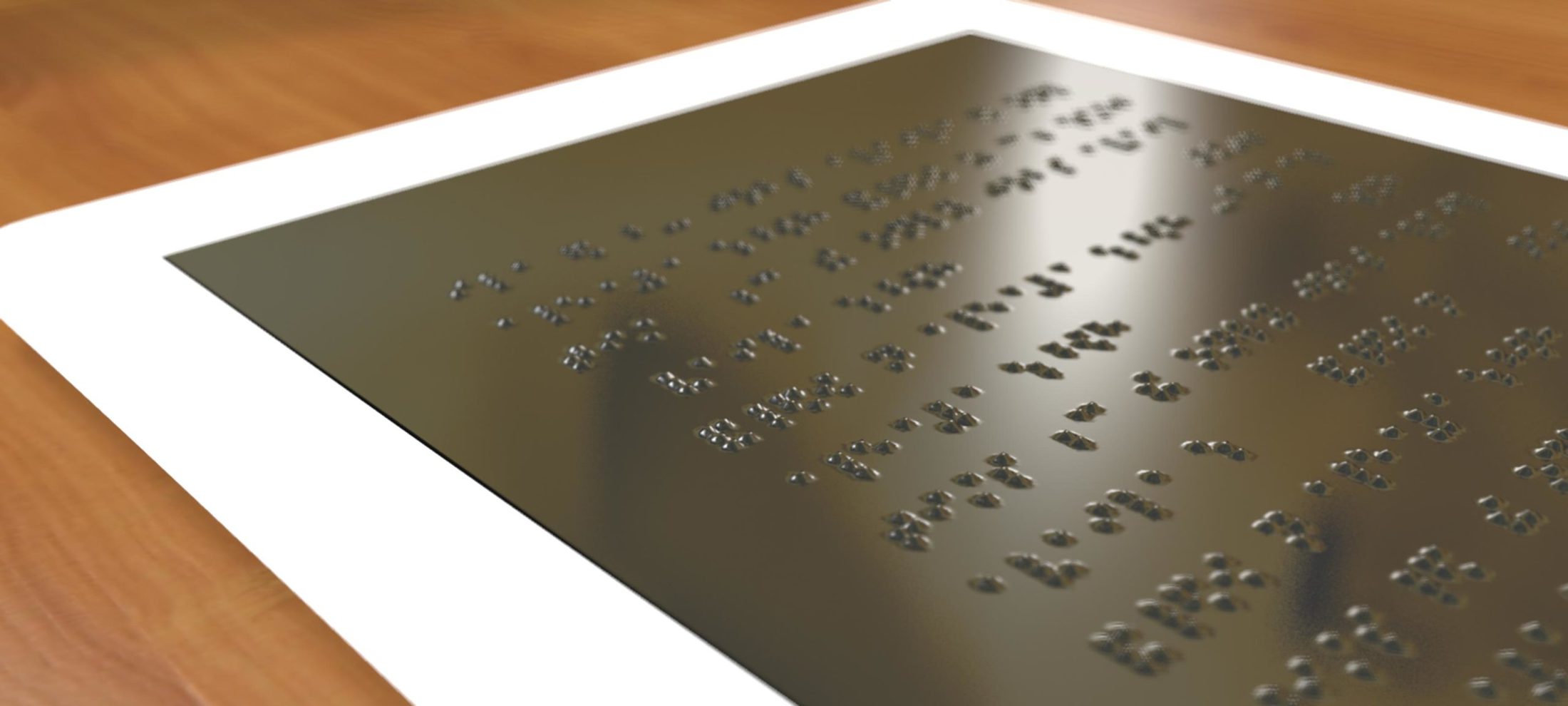
Bringing Braille back with better display technology
It’s slow to read computer screens with today’s Braille displays, and the 200-year-old code is declining in use. New technology from Michigan Engineering aims to help bring Braille back.

It’s slow to read computer screens with today’s Braille displays, and the 200-year-old code is declining in use. New technology from Michigan Engineering aims to help bring Braille back.
Today, blind people fluent in Braille can read computer screens through refreshable displays that convert words to raised dots – but only one line at a time.
For the sighted, imagine a Kindle that presents just 40 characters per page, says Sile O’Modhrain, an associate professor of Music, Theatre and Dance at U-M, who is blind. Forty characters amounts to about 10 words.
The process is slow. It doesn’t give context. It’s expensive. And O’Modhrain believes it’s one of the factors contributing to Braille’s declining use. Even though fluency in the nearly 200-year-old code is linked with higher employment and academic performance for the visually impaired, fewer blind people are learning and using it. Taking Braille’s place are text-to-speech programs that make it easier and faster to consume electronic information, but at the same time, hold back literacy.
So O’Modhrain, who is also in the School of Information, has teamed up with engineering researchers to build a better Braille display – one that could show the equivalent of a whole Kindle screen at once. In addition, it could translate beyond text, rendering graphs, charts, spreadsheets, maps and complicated equations in a medium the blind could more fully understand with their fingertips.
“What we’re trying to build in this project is full-page tactile screen for something like a Kindle or an iPad where you could just display refreshable text in real time,” O’Modhrain said. “Relative to what’s done today, and how that’s done, it’s a complete paradigm shift.”

In the 1950s, about half of blind children learned to read Braille, according to the National Federation of the Blind. Today, that number is just 10 percent. Yet 80 percent of the blind people who are employed know Braille. Those numbers don’t tell the whole story, as definitions and health outcomes have evolved over the years. But the trend they suggest is real.
“When you’re learning to read and write, it’s hard to find a substitute for physically encounter text – whether it’s in visual or tactile form,” O’Modhrain said. ”There are many studies that show that listening to something is not the same as reading it.”
The system she is developing with Brent Gillespie, an associate professor of mechanical engineering, and Alex Russomanno, a doctoral student in the same department, would make e-reading for the blind more efficient and a lot less expensive. Today’s commercial one-line Braille displays cost around $5,000. If you were to directly scale up the mechanism behind it to show a whole page, it would cost around $50,000, Russomanno says. The U-M researchers’ aim to offer that capability at just $1,000 per device.
How can they make a bigger display at a fraction of the cost? Their answer is microfluidics – a branch of science and engineering that involves specially etched chips with tiny channels that guide flows of liquid or air. Microfluidic chips are modeled and made like the integrated circuits of computers. They are printed rather than assembled.
“We use the equivalent of electronic logic and circuitry,” Russomanno said. “When I say that, I’m referring to the way a computer works, with transistors and resistors, except ours is not electronic at all. It’s fluidic. Instead of high voltage and low voltage you have high pressure and low pressure, and instead of electric current flow you have fluid flow and you can achieve the same basic logic features.”
We would like to think a device like this would make reading electronic Braille more attractive again, make it close to the experience of reading a traditional book…
Sile O’Modhrain
And like the 0s and 1s that undergird computing, Braille is a binary code. Each Braille cell (which is sometimes a letter and sometimes a whole word) contains six dots that can be either raised or flat to convey different information.
“The dots are either there or they’re not,” O’Modhrain said. “That’s why this circuit is so elegant.”
With just two input valves, the researchers are able to generate more than 50 different dot states. The valves move fluid that controls tiny bubbles that raise or lower dots.
At this point, they’ve shown that they can drive the dots with bubbles, and that they can print a microfluidic device that could let them efficiently control those bubbles. Over the next year, they’ll be working to integrate the two and produce a larger prototype.
“We would like to think a device like this would make reading electronic Braille more attractive again, make it close to the experience of reading a traditional book,” O’Modhrain said. “Another challenge is convincing educational authorities to teach Braille again. It has dropped out of the system in terms of the education of blind people and we think it’s important to bring Braille back.”